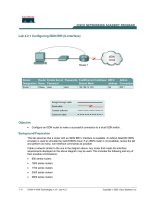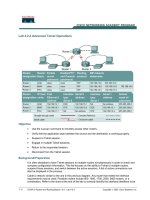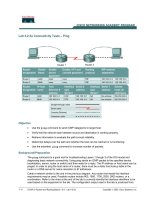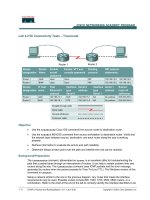Tài liệu Lab 4.2.2 Establishing and Verifying a Telnet Connection pdf
Bạn đang xem bản rút gọn của tài liệu. Xem và tải ngay bản đầy đủ của tài liệu tại đây (254.91 KB, 5 trang )
Lab 4.2.2 Establishing and Verifying a Telnet Connection
Objective
• Establish a Telnet connection to a remote router.
• Verify that the application layer between source and destination is working properly.
• Retrieve information about remote routers using show commands.
• Retrieve CDP information from routers not directly connected.
Background/Preparation
This lab focuses on the Telnet (remote terminal) utility to access routers remotely. Telnet is used to
connect from a local router to another remote router in order to simulate being at the console on the
remote router. The local router acts as a Telnet client and the remote router acts as a Telnet server.
Telnet is a good testing or troubleshooting tool since it is an application layer utility. A successful
Telnet demonstrates that the entire TCP/IP protocol stack on both the client and server are
functioning properly. Telnet from the workstation as a client into any router with IP connectivity on the
network. In addition, telnet into an Ethernet switch if an IP address has been assigned.
Cable a network similar to the one in the previous diagram. Any router that meets the interface
requirements may be used. Possible routers include 800, 1600, 1700, 2500, 2600 routers, or a
combination. Refer to the chart at the end of the lab to correctly identify the interface identifiers to be
used based on the equipment in the lab. The configuration output used in this lab is produced from
1 - 5 CCNA 2: Routers and Routing Basics v 3.0 - Lab 4.2.2 Copyright 2003, Cisco Systems, Inc.
1721 series routers. Any other router used may produce slightly different output. The following steps
are intended to be executed on each router unless specifically instructed otherwise.
Start a HyperTerminal session as performed in the Establishing a HyperTerminal session lab.
Note: Go to the erase and reload instructions at the end of this lab. Perform those steps on all
routers in this lab assignment before continuing.
Step 1 Configure the routers
a. If there are any difficulties configuring hostname or passwords, refer to the Configuring Router
Passwords lab. If there are any difficulties configuring interfaces or the routing protocol, refer to
the Configuring Host Tables lab.
b. Verify the configurations of the routers by performing a show running-config on each router.
If not correct, fix any configuration errors, and verify.
Step 2 Login to Router 1 and verify the connection to Router 2
a. Login to the Gadsden router in user mode.
b. Verify the connection between the two routers. Ping the serial 0 interface of the Birmingham
router. If the ping is not successful, return to Step 1 and troubleshoot the configuration.
Step 3 Use help with the telnet command
a. Enter telnet ? at either the user EXEC or the privileged EXEC router prompt.
b. What did the router reply with?
__________________________________________________________________________
Step 4 Telnet to a remote router
a. Enter telnet router-name if IP host tables were configured. Otherwise, enter IP address
at the router prompt to connect to a remote router.
b. What prompt did the router display?
____________________________________________
Step 5 Look at the interfaces on the remote router
a. Enter show interface at the router prompt.
b. List the interfaces, their IP address and subnet masks:
Interface IP Address Subnet mask
Step 6 Display the protocols on the remote router
a. Enter show protocols at the router prompt.
b. Fill in the following table with the information that was generated by the remote access router.
Interface
Is there a Carrier Detect
signal
Are the keepalive messages
being received?
2 - 5 CCNA 2: Routers and Routing Basics v 3.0 - Lab 4.2.2 Copyright 2003, Cisco Systems, Inc.
Step 7 Enter privileged EXEC mode
a. Enter enable at the command prompt. Enter the password class.
b. What prompt did the router display? What mode is this?
__________________________________________________________________________
Step 8 Look at the running configuration
a. Enter show running-config at the remote router prompt.
b. What file is being viewed on the remote router? Where is this file stored?
__________________________________________________________________________
Step 9 Look at the saved configuration
a. Enter show startup-config at the router prompt.
b. What file is being viewed on the remote router? Where is this file stored?
__________________________________________________________________________
c. What information is seen concerning the line VTY connections?
__________________________________________________________________________
Step 10 Look at the neighbor configuration
a. Enter show cdp neighbors command at the router prompt.
b. List all device IDs that are connected to the remote router with a Telnet session.
__________________________________________________________________________
Upon completion of the previous steps, logoff by typing exit. Turn the router off.
3 - 5 CCNA 2: Routers and Routing Basics v 3.0 - Lab 4.2.2 Copyright 2003, Cisco Systems, Inc.
Erasing and reloading the router
Enter into the privileged EXEC mode by typing enable.
If prompted for a password, enter class. If “class” does not work, ask the instructor for assistance.
Router>enable
At the privileged EXEC mode, enter the command erase startup-config.
Router#erase startup-config
The responding line prompt will be:
Erasing the nvram filesystem will remove all files! Continue?
[confirm]
Press Enter to confirm.
The response should be:
Erase of nvram: complete
Now at the privileged EXEC mode, enter the command reload.
Router(config)#reload
The responding line prompt will be:
System configuration has been modified. Save? [yes/no]:
Type n and then press Enter.
The responding line prompt will be:
Proceed with reload? [confirm]
Press Enter to confirm.
In the first line of the response will be:
Reload requested by console.
After the router has reloaded the line prompt will be:
Would you like to enter the initial configuration dialog? [yes/no]:
Type n and then press Enter.
The responding line prompt will be:
Press RETURN to get started!
Press Enter.
The router is ready for the assigned lab to be performed.
4 - 5 CCNA 2: Routers and Routing Basics v 3.0 - Lab 4.2.2 Copyright 2003, Cisco Systems, Inc.
Router Interface Summary
Router
Model
Ethernet
Interface #1
Ethernet
Interface #2
Serial
Interface #1
Serial
Interface #2
Interface
#5
800 (806) Ethernet 0 (E0) Ethernet 1 (E1)
1600 Ethernet 0 (E0) Ethernet 1 (E1) Serial 0 (S0) Serial 1 (S1)
1700 FastEthernet 0 (FA0) FastEthernet 1 (FA1) Serial 0 (S0) Serial 1 (S1)
2500 Ethernet 0 (E0) Ethernet 1 (E1) Serial 0 (S0) Serial 1 (S1)
2600 FastEthernet 0/0
(FA0/0)
FastEthernet 0/1 (FA0/1) Serial 0/0 (S0/0) Serial 0/1
(S0/1)
In order to find out exactly how the router is configured, look at the interfaces. This will identify the type of router
as well as how many interfaces the router has. There is no way to effectively list all of the combinations of
configurations for each router class. What is provided are the identifiers for the possible combinations of interfaces
in the device. This interface chart does not include any other type of interface even though a specific router may
contain one. An example of this might be an ISDN BRI interface. The string in parenthesis is the legal abbreviation
that can be used in IOS command to represent the interface.
5 - 5 CCNA 2: Routers and Routing Basics v 3.0 - Lab 4.2.2 Copyright 2003, Cisco Systems, Inc.









